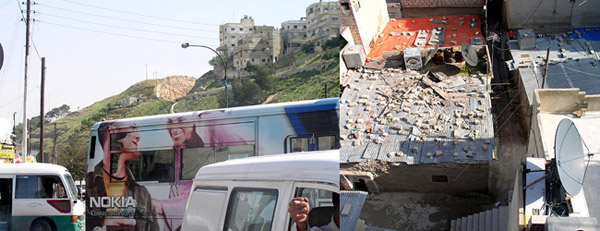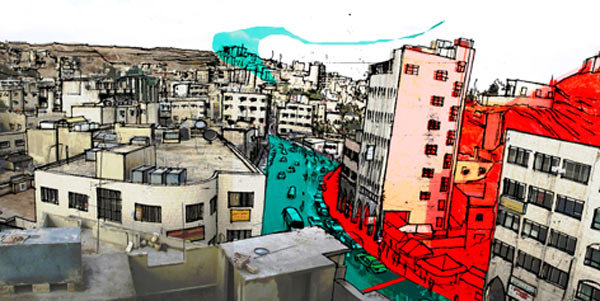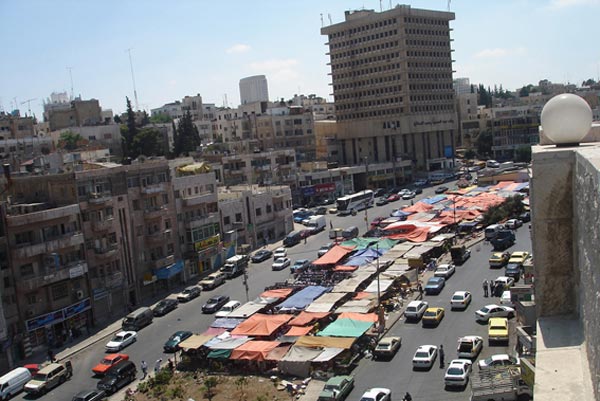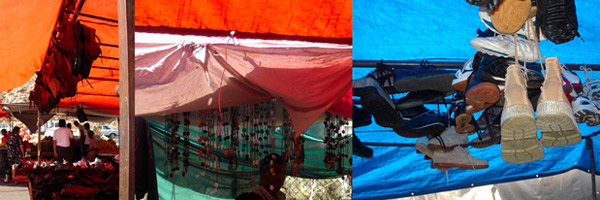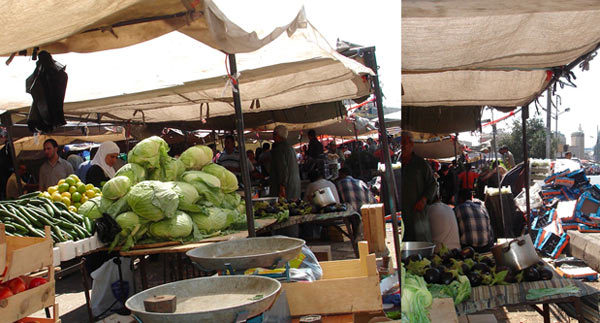City of Events: a Close Look at Al Abdali Bus Terminal and Beyond
The city of Amman enters a new age, where cities of the region grow towards patterns of urban living that are portrayed to enable cities to outlive change in a politically and economically tough situation. Those patterns are stationed around capital accumulation deriving from cities’ capacities for consumption of all sorts. Putting on display the city as a field of opportunities, by creating a free market liberated from the state, and generating a fully commodified form of social life through large-scale development practices and regeneration projects, targeting highly significant and meaningful places in the city, promoting, circulating a “theme” of an Image of how life should be, an extracted image from The Capital of privatized public landscapes targeting a very particular customer rather than a user. By imposing an every day scenario of accumulative consumption, the city turns into an image, a commodified experience. Current urban development practices address a procedure that is enforced “from above”, a pure imageability, that exceeds the intended design to a life style promoted by it.
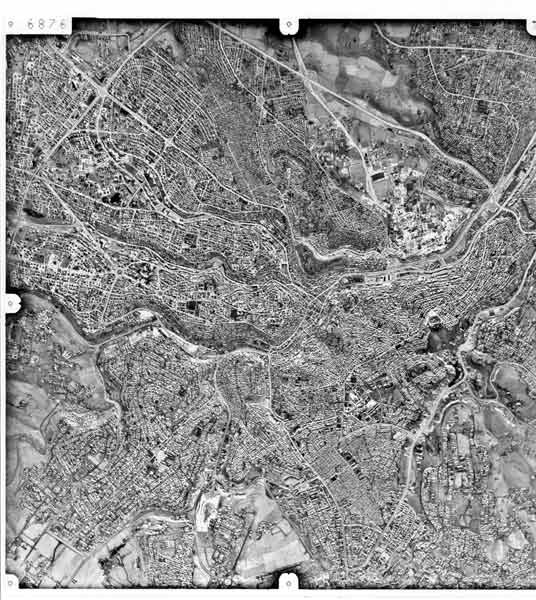
areal view of East Amman, 1992
A life style replacing what is already there and working in harmony with a unique fabric of its own. An unreal commodified image, hygienic, new, neo liberal environment excluding the marginalized and dislocating them and their place of memory increases by that the spatial and the social segregation in the city. “Planning for modernity seems to be predicated on the necessity of the displacement of the poor from the urban fabric”, Seteny Shami.
Such development practices render a start to form a concrete base for new horizon for future liberated investments. This triggers a excessive degree of marginalization, gentrification, dislocation of what made a relatively young history of the modern Amman significant at the first place, through a shifting processes in order to trace potentials of “money” around the city. Al Abdali urban regeneration project is a strategic development in the heart of the Heart of the capital Amman - converting a 34 hectar military camp site into what is considered to be the most prestigious mixed - used environment in Jordan, according to Al Rai Newspaper.

Downtown Amman; Al Husseini Mosque, Faisal Square
The Shift
If we follow the spine of Al Abdali, trying to map out traces of developments practices on such an area aiming downtown , extending far to the city core, a very much similar tissue to Al Abdali will be found: Faisal Street, the origin of the modern city of Amman. For decades ago, Faisal Street had been demonstrating an eventful set up; the public Saha. Hotels, coffee houses, restaurants.. etc, all emerged as a natural result for a place that was a celebrative point of arrival to the city **, an influx coming from the surrounding cities of Bilad Al Sham, with a strong presence of Al Husseni Mosque and Al Seil, a stream of water, had been laying in the valley behind the mosque, formed a hub that evacuated the flow of merchants from the mosque square to the natural strip in the valley (Al Seil) in highly formal and informal ways of adaptations and accommodations (open air markets were naturally and spontaneously formed). This unconstrained evolution associated the area with a matchless significance, due to the aura of the mosque allied by the consequent social behaviors which had extended the quality of the Husseini Mosque Square of being legitimate. An event was continually reproduced among a dialogue indicating a very dynamic representation of the everyday life. The actors addressing that dialogue involved: The State (the representation of Al Saha) + the mosque (religion) + coffee house (the local and the regional intellect), Al Seil (locals, dwellers, sellers.. ).
It was a very dynamic representation of the every day life. The involvement of the multiple actors, local and regional of Bilad al Sham, where active political criticism and action had been mediated and initiated to the whole city, triggers a core of public politics and a record of real concrete sphere of the public in Amman that once existed. The every day life was a series of reactions to a certain decision taken by the state to have a politically significant plaza at that place, which happened to have just the right environment to grow an event around itself, by the users of the place themselves. It was a whole social product.
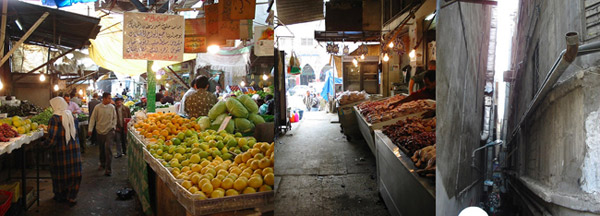
vegetable market adjacent to Souq Al- Haramiyyeh
As a result of the 1967 war, the State became unable to cover increasing population needs. Vast and wide building expansion and rapid infrastructure was needed, having in mind that Seil (the river) had flooded the city center several times and caused pollution problems, the wise solution seemed to be covering the Seil, replacing it with a connection of asphalt. By the destruction of Al Seil, parallel to the absent of Al Saha little by little Al Saha was voided of its events, the mosque was no longer performing as a zone of influence, and the aura shrunk to include the square of the mosque, which also start to perform mainly as an entrance. That was may be the first realization of the shift, which happened by the replacement of the natural element, and the sudden fill which determined a monotones architecture along the strip (the feature of linear continuous arcades) filling the massive sudden void against the mountain which formed an easy place to be adapted by the locals who accommodated the element of Al Seil in the valley as an atmosphere for exchange.
It had been their way of living, with replacing it in the name of development.
With the presence of the car, a new sense of space, time and speed, created a plane of motion, a tempo that differs from what was happening at that time.. having said that, the speed of the street made possible by replacing the stream of water with a stream of cars. “Saqf Al Seil Street” started a period of brief and fast growth that determined the standard monotonous feature of the street. A moment of resistance to this place taken by the locally marginalized users of Al Seil reproduces resistance in every day life in form of collective adaptive behavior as a response to a humanly estranging but an area that many people depend on economically.
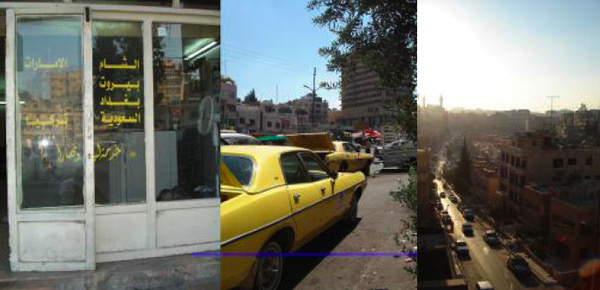
traveling agencies and their cars in Al Abdali
With Seils location being aligned to another bus terminal, Raghadan, the rushing cars and people, made it possible to have clustered functionalities, sometimes in vertical forms. Hotels, coffee houses, restaurants all emerged along the hub. You can see relatively high buildings standing against the mountain; hotels and coffee houses, as opposed to underground voids and alleys; the shops at the level of Al Seil level, adapted by local sellers who are installing in space smuggled commodities clothes and shoes, vegetables, etc.. even antiques, are amazingly found and targeted from many places.
Parallel to all that a piece of land laying in the valley between Jabal Al Hussein an Jabal Al Weibdeh (Al Abdali), was also some how evacuating Faisal Street as a link to other cities. The traveling agencies that stayed in Faisal Street till the end of the 50s, found a replacement to Al Saha in Al Abdali. For example Al Alameen Travel Agency which was exactly adjacent to Al Jjame’a al Arabeyyeh coffee house (at the end of Faisal Street) till 1958 had shifted their office two years later; 1960, becoming Al Amer Travel Agency in Al Abdali.
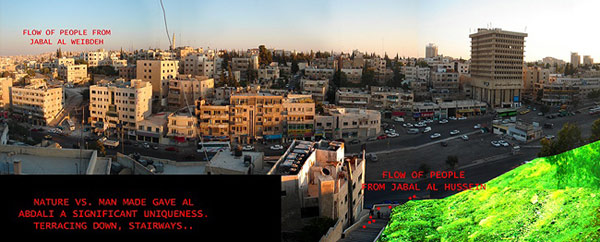
view on Al Abdali laying in the valley between Jabal AL Hussein and Jabal Al Weibde
As Seteney Shami indicated: “...Cities in general, are marked by high mobility, movements, to form and within the city are critical information of urban society.. high mobility means that there is constant change in the individual who forms the city, as well as in the nature and the size of different social groups and classes hierarchies, therefore are continually reproduced but with variations over time...”. In the constant patterns of development practices targeting a place of opportunity in the city replacing those, such as the Al Abdali Regeneration Project which is introducing a new imposing city center to the city which in many ways threatens the existing tissue in Al Abdali, especially with the shift of the bus terminal to “Tabarboor” a more of a periphery to Amman linking to “Yajooz” leading to Al Zarqa highway (which also is experiencing a huge development plan of expansion towards Amman). Such a project does not only impose a new city down town but also dislocates the peoples’ link to their downtown by shifting the flow motion.
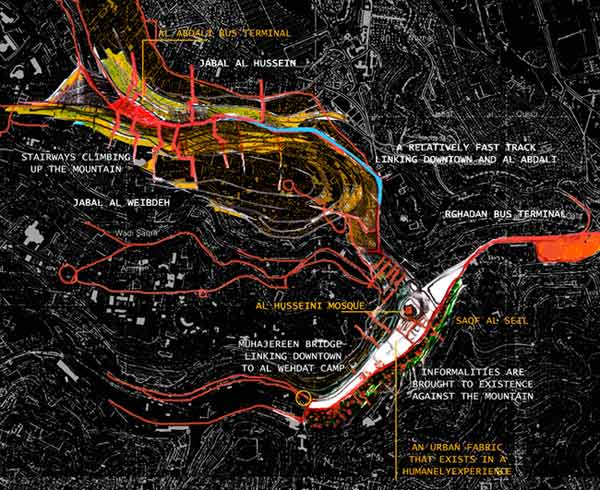
map diagram, link between Al Abdali, Faisal Square, Saqf Al Seil and the shift that took place
Al Abdali as a Social Product: When man and the car meet.
Function was articulated and reproduced in a tissue of encounters, interrelations between what is public and what is private; between movement and settlements.
Spaces become highly accommodated informs of networks which are invented and
stimulated by the hub. Such richness becomes able to unfold potentials, enforcing the existing and becoming informalities and accommodations in a program of collaboration of processes of a constant feeding and production. It’s a space sculpted by the motion of the people. Stair ways climbing up the mountain, in opposition to cuts of light between the man made and the natural, reaching the valley in a very rhythmic way.
A rich void hovering between the two mountains, contemplating their strong settlements. This void is being constantly readapted and reused by different kinds of users; dwellers, drivers, sellers, employees, passengers, students, ..etc, brought into existence hotels, restaurants, coffee houses, travel agencies, later airways offices, banks, ..etc. Unfolding different urban stories, becoming more of a gate way to the downtown, marking the mountains and linking west of Amman to the east.
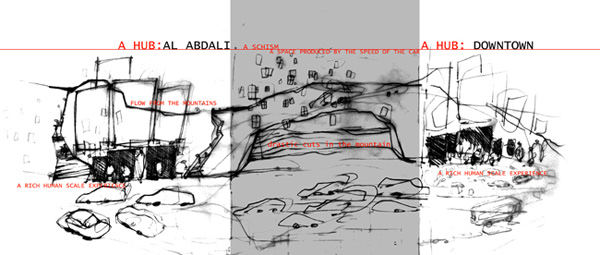
diagram showing transition when crossing Al Salt Street from Downtown to Al-Abdali and vice versa
When destinations are more important than what is being crossed, and speed is the desire, places start to die. Warehouses, workshops, printeries, as well as the institutional buildings are more pushed from Al Abdali to the downtown direction and the other way around; King Hussein Street (Al Salt Street), a strip that co-exists a long the link between downtown and Al Abdali - the two vital hubs - feeding each other by a strip that is almost a schism between the settlement and the movement.
What makes it even more poor in terms of experience, that it’s a strip occupied by
daylight functions that lacks the street level experience of the shop façades (in
opposition to a pedestrian alley experience of downtown and Al Abdali); car garages, warehouses, ..etc, imposing their structures against the mountain, so at night the only thing alive is the lit windows above the mountains, and the only link between the relatively fast strip and the upper settlements are cuts of light in the mountains reaching to the asphalt and the steep stair ways. It’s a space produced by the car.
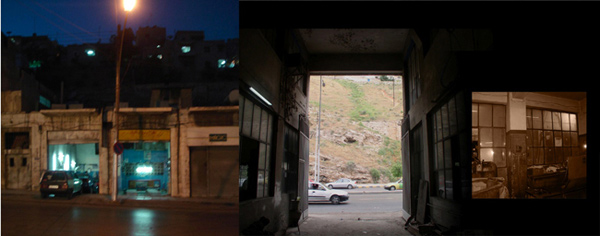
workshops imposed against the mountains
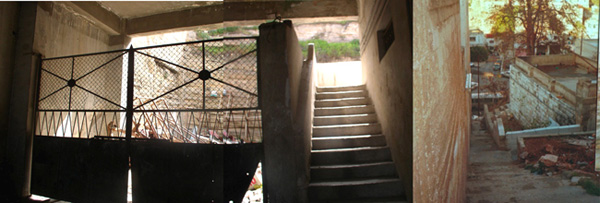
staircases and cuts of light reaching the street, 2005
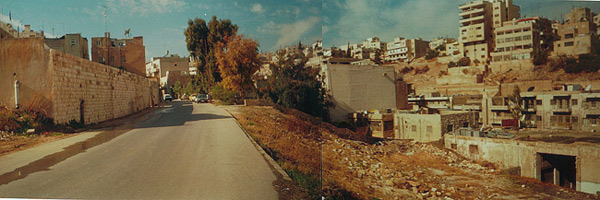
view from Jabal Al Weibdeh to the roof tops of the workshops

street experience of the link between Al Abdali and Downtown

view to Al Salt Street from above; the street elevation seems alienated from the life happening above
Such a machinery of place, where the informalities are increasing against the planned space, growing a public sphere, becoming a social program, a dialogue that is circulating around the city as a result of multi-layered connectivity, stimulation of urban stories of every day life - the influx from all the directions, being the point of arrival to the city, the mountain unloading dwellers down to the valley, drivers, students going to their universities, Made Al Abdali capable of unfolding potentials and enforcing “happening and becoming informalities and accommodations” which made it possible for an event like the Friday Market; open air second hand clothes and vegetable market, to take place in the adjacent parking to the bus terminal. The open-air market fist started to emerge in the 70's taking place every Monday and Wednesday, when Al Abdali was starting also to flourish as a link to the region; Syria, Lebanon, Iraq and the Gulf also after the oil. It emerged as a need more than anything else.
Till the 80s it was in an empty plot ( the location of the post office now) which was just against Al Albdali. Then it was shifted to the empty parking area that belongs to the bus terminal taking place every Friday; the Friday Market.
Vegetables are brought from the Central Market, Al Hussein Camp, in Friday nights, or in the very early hours of Friday mornings. The rest of the commodities, secondhand clothes, furniture, etc… are brought the night before and set in the site waiting for the morning. The goods displayed in the open-air market are usually kept for rest of days of the week, in stores all over the city, Al Hasmy, Jufeh and of course in the stores of Downtown, behind the Husseini Mosque, and in the Telyani Street; a street famous for secondhand clothes parallel to Saqf Al Seil Street. Some of the Commodities are installed in space till a late hour of the day, so that their owners could directly move them to Al Qwaismeh open-air market ; the Saturday Market, which is nearly 5 times less expensive than the Friday market!
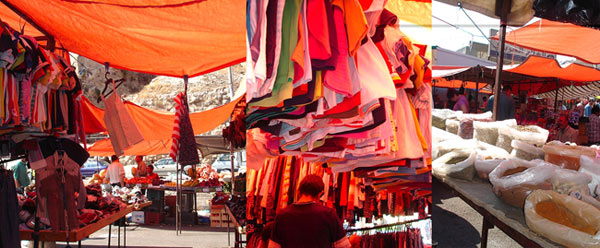
secondhand clothes installed in the space of the valley with the mountain in the background, Friday Market

Al Abdali bus station and Friday Market

place of the Friday Market and bus station
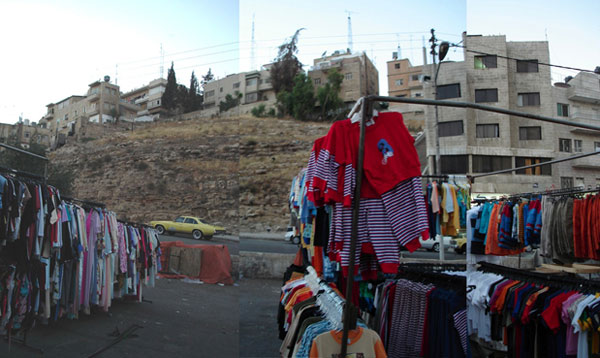
Friday Market facing the mountain
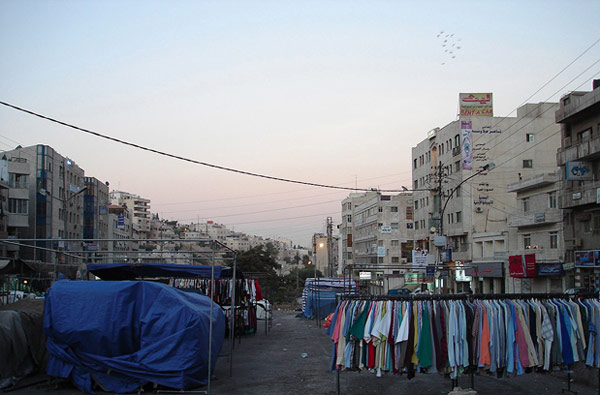
Friday Market, view towards Downtown
Those two open-air markets are the only ones which are still taking place in the same old way. The actors of the place, merchants who have been the oldest in the business, usually pick an open space in a certain area and discuss its potential of being an open-air market with the municipality. If approved, later it will be divided and marked into equal shares (each shares’ rent is 2JD), then distributed on the merchants. Other open-air markets used to take place in Wehdat Refugee Camp, Mahatta Camp, Jabal Al Naser and Emteeneh in Jabal Al Joufeh. All of these markets have been cancelled by the Muncipality except the Al Wehdat Market, but in another form though. Al Wehdat open-air Market had been turned into a permanent closed hanger, which kind of lost some of its popularity and only servicing the adjacent areas. The merchants of such different markets are the same people; a group who is touring the city, with almost the same commodities is now discussing with the Municipality their future with the shift of the bus terminal happening soon. They are trying to know what are their chances of having a place their.
Is there going to be any “place” could let people improvise? Would they become excluded from such a development, replaced and moved to another place? Would the development offer a substitute plan to such an informality? A substitute that promises to be organized and controlled? Under the spot of the current development’s hidden agendas, would they become a subject of social injustice in another turn of marginalization and dislocation? Would the notion of the open-air markets and the different informalities continue to disappear? What quality does the open market add to the peoples’ informal existence? Does the permanent quality suppress the local informalities? Is the municipality not being tolerant enough towards such informalities? Though they are more organized and controlled as they may seem. Are we minimizing the existence of the open-air markets, though they are a result of a the locals’ need, and at the same time promoting markets such as the Jara Market in Rainbow Street; a more of a touristic open-air market that is targeting another social and economic class, in a highly significant place based on classifications of what is valuable and what is not, and putting that significance in the display..
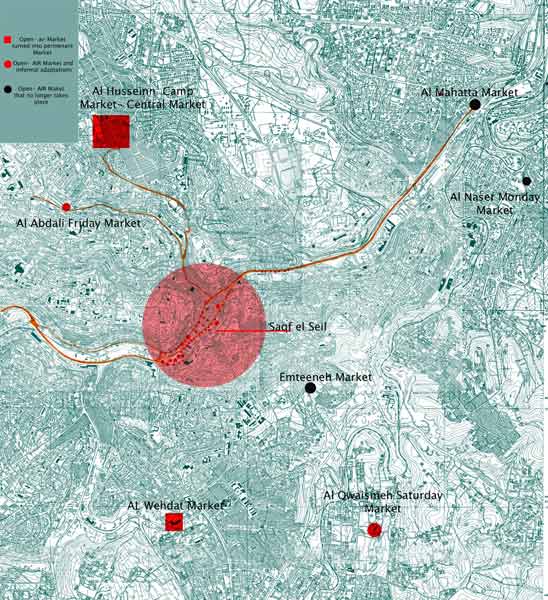
Tracing the spots of the open-air markets that are currently taking place and the ones that used to take place
By shifting Al Abdali bus terminal, not only we are detouring a flow, we are extracting more than 30 years from the contemporary history of the city. To a city that is relatively young, 30 years are a lot. We are taking out a tissue that was created and improvised by the people, a way of living. We all know that a city is more of a machine, which is possible to be comprehended. But the reality that we can not embrace in planning from above, is the chemistry of the city.
Conclusion: Suppressing the Collective Experience towards an Individual Memory
It’s a fact that the urban realm no longer carries with it all those aspirations of
individuals and the collective experience. Those aspirations have been absorbed in the increasing accumulation of capital, and the dematerialization of dominant spaces of consumption, parallel to the extreme materialization of “capital” spaces where the experience of place and places of experience withdraw into a becoming image and commodity signs articulated with the promise of exchange and a contemporary living for a place loaded with contradictions taking this specified form of a geographic territory where the “public” is being raised as a matter of wholeness of the individuals under the floating urban situation.
To whom the city is being planned for ?
Who is the real citizen of the city? Me and you, or the investor?!
** Referring to a discussion held with Dr. Rami Daher
images, collages and sketches, 2004/2005 and text, 2005/2007 by Saba Innab, Amman, Jordan
City of Events: a Close Look at Al Abdali Bus Terminal and Beyond
ANOTHER PROJECT ON CITYSHARING
→ up the hill down the hill - Bird Cages - an installation
RELATED WEB SITES
→ sketches for an essay
→ exhibition of artist
→ work in-situ, Shatana, Jordan
→ Gazette contribution
→ work in-situ, Shatana, Jordan
→ park project
→ landscape and/or architecture
→ Saba Innab CV - 2010
[ A Rug - Post-orientalism ]
[ Cairo Divided ]
• City of Events: a Close Look at Al Abdali Bus Terminal and Beyond •
[ DADA Houses & Bucharest Strip ]
[ DIWAN ]
[ Die letzte Buche - The last beech ]
[ Leerstand ]
[ Model Citizens ]
[ Mukhattat mabdaee lilmustaqbal—Blueprint of the Future ]
[ Presence ]
[ Psychogeography ]
[ R I C O R S O ]
[ Reaching Boundaries ]
[ up the hill down the hill - Bird Cages - an installation ]
FEATURED THEME ON CITY SHARING
by ASUNCION MOLINOS GORDO
-
This project is an instrument for common critical analysis to help understand the reasons behind Egyptians’ diminishing …
by INAS HALABI
-
The project Letters to Fritz and Paul focuses on the expeditions of the Swiss cousins, lovers and scientists, Fritz and …
by SARAH BURGER
-
The planned modern city of Brasilia attracted me since a long time. Her defined shape, location and function proceded he …
by ADRIEN GUILLET
-
Youri Telliug talks with the artist Adrien Guillet about his project Citracit
Youri Telliug - What is Citracit …
by NIGIST GOYTOM
-
In 2013 more than 45 million people have been forced to leave their homes. This amounts to the biggest number of refugees …
by SULAFA HIJAZI
-
The on going debate on Arab identity and its (cultural) representation is strongly shaped by Edward Saidʼs formative …
by ASUNCION MOLINOS GORDO
-
WAM is a site-specific work that uses the historical trope of the cabinet of curiosities to explore the introduction of …
MORE CONTRIBUTIONS BY THE FOLLOWING
